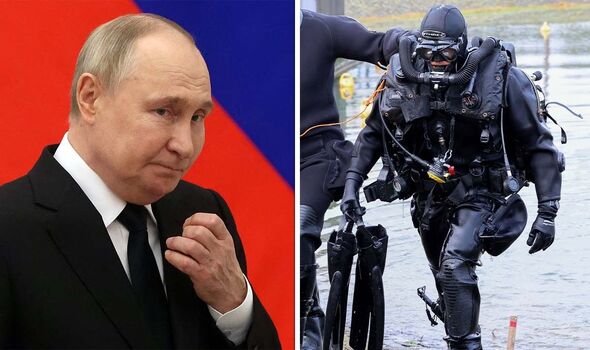A Nato commander has warned that if Russia attacks underwater infrastructure it could send Europe’s economies into meltdown.
Deputy commander of Nato’s Allied Maritime Command Vice Admiral Didier Maleterre said that if Russia attacks infrastructure that feeds power cables and wind farms it could impact the security and safety of close to one billion people.
V Adm Maleterre said that the vast and complicated network of underwater cables and other infrastructure was not designed to deal with a new type of warfare being waged under the sea.
In the event of World War 3, these pipes and wires could be vulnerable to attack from enemy military personnel and significantly impact those in Europe and the USA.
Speaking to the Guardian V Adm Maleterre explained just how much of the UK and Europe’s assets were connected to the pipes running beneath the water’s surface.
He said: “We know the Russians have developed a lot of hybrid warfare under the sea to disrupt the European economy, through cables, internet cables, pipelines.
“All of our economy under the sea is under threat.”
However, V Adm Maleterre reassured that Nato was aware of what Russia could be capable of and was “not naïve” to the potential threats.
V Adm’s Maleterre’s warnings come after suspected attacks on the Nord Stream 1 and 2 pipelines a few years ago and the Baltic Connector in October.
He added: “It’s a security issue for nearly 1 billion Nato-nation civilians. We need to be protected and well supplied by our vital undersea infrastructures.”
While there is great concern about the potential for Russia or enemy states to wreak havoc in the event of war, Britain is well-prepared to combat such a threat.
Speaking to Express.co.uk, Professor of War and Strategy in East Asia Alessio Patalano said the Royal Navy was well-prepared to deal with a series of undersea threats.
Professor Patalano explained: “There are at least three different types of undersea activities, demanding different types of capabilities.
“Surveillance – which requires mines, seabed sensors, drones; sea denial – which requires divers, drones, mines, and submarines; and sea control – which now includes seabed warfare – and demands submarines and drones.
“In addition, deep-dive search and rescue capabilities are important for any type of ambition to operate undersea.
“The Navy possesses capabilities to perform all of these activities – with the depth and range of each of them depending on where these missions are pursued.”
